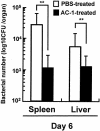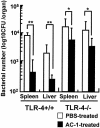Immunostimulating properties of intragastrically administered Acetobacter-derived soluble branched (1,4)-beta-D-glucans decrease murine susceptibility to Listeria monocytogenes
- PMID: 15557623
- PMCID: PMC529118
- DOI: 10.1128/IAI.72.12.7005-7011.2004
Immunostimulating properties of intragastrically administered Acetobacter-derived soluble branched (1,4)-beta-D-glucans decrease murine susceptibility to Listeria monocytogenes
Abstract
We previously found that AC-1, an extracellular polysaccharide, produced by Acetobacter xylinum and composed of (1,4)-beta-D-glucan with branches of glucosyl residues, showed a strong activity to induce production of interleukin-12 (IL-12) p40 and tumor necrosis factor alpha by macrophages in vitro via Toll-like receptor 4 (TLR-4) signaling. In the present study, we examined the effect of oral administration of AC-1 on protective immunity against Listeria monocytogenes. Mice were given AC-1 or phosphate-buffered saline (PBS) intragastrically 2 days before, on the day of, and 2 days after an intraperitoneal inoculation of L. monocytogenes. The survival rate of AC-1-treated mice was significantly improved and bacterial growth in AC-1-treated mice was severely retarded compared to those of PBS-treated mice after infection with L. monocytogenes. IL-12 p40 levels in serum and magnitudes of CD4+ Th1 and CD8+ Tc1 responses against Listeria antigen were significantly higher in AC-1-treated mice than in PBS-treated mice. The effect of AC-1 on antilisterial activity was diminished in C3H/HeJ mice carrying mutated TLR-4. Thus, AC-1, a potent IL-12 inducer through TLR-4, enhanced protective immunity against L. monocytogenes via augmentation of Th1 responses. These results suggest that infectious processes driven by intracellular microorganisms could be prevented to develop by the (1,4)-beta-D-glucan.
Figures







Similar articles
-
Soluble branched (1,4)-beta-D-glucans from Acetobacter species enhance antitumor activities against MHC class I-negative and -positive malignant melanoma through augmented NK activity and cytotoxic T-cell response.Int J Cancer. 2005 Jul 10;115(5):769-76. doi: 10.1002/ijc.20934. Int J Cancer. 2005. PMID: 15729692
-
Immunohematopoietic modulation by oral β-1,3-glucan in mice infected with Listeria monocytogenes.Int Immunopharmacol. 2010 Dec;10(12):1573-9. doi: 10.1016/j.intimp.2010.09.009. Epub 2010 Oct 15. Int Immunopharmacol. 2010. PMID: 20951668
-
Effect of 6-hydroxydopamine on host resistance against Listeria monocytogenes infection.Infect Immun. 2001 Dec;69(12):7234-41. doi: 10.1128/IAI.69.12.7234-7241.2001. Infect Immun. 2001. PMID: 11705892 Free PMC article.
-
Alteration of non-specific resistance to infection with Listeria monocytogenes.Infection. 1988;16 Suppl 2:S112-7. doi: 10.1007/BF01639732. Infection. 1988. PMID: 3138182 Review.
-
Interleukin-4 and listeriosis.Immunol Rev. 1997 Aug;158:95-105. doi: 10.1111/j.1600-065x.1997.tb00995.x. Immunol Rev. 1997. PMID: 9314077 Review.
Cited by
-
Immunomodulatory Effect of Cordyceps militaris Polysaccharide on RAW 264.7 Macrophages by Regulating MAPK Signaling Pathways.Molecules. 2024 Jul 20;29(14):3408. doi: 10.3390/molecules29143408. Molecules. 2024. PMID: 39064986 Free PMC article.
-
Developing Phytocompounds from Medicinal Plants as Immunomodulators.Adv Bot Res. 2012;62:197-272. doi: 10.1016/B978-0-12-394591-4.00004-0. Epub 2012 Jun 19. Adv Bot Res. 2012. PMID: 32300254 Free PMC article.
-
In Vitro Utilization of Prebiotics by Listeria monocytogenes.Microorganisms. 2024 Sep 11;12(9):1876. doi: 10.3390/microorganisms12091876. Microorganisms. 2024. PMID: 39338550 Free PMC article.
-
Host genetics of Bordetella pertussis infection in mice: significance of Toll-like receptor 4 in genetic susceptibility and pathobiology.Infect Immun. 2006 May;74(5):2596-605. doi: 10.1128/IAI.74.5.2596-2605.2006. Infect Immun. 2006. PMID: 16622195 Free PMC article.
-
Acetan and Acetan-Like Polysaccharides: Genetics, Biosynthesis, Structure, and Viscoelasticity.Polymers (Basel). 2021 Mar 7;13(5):815. doi: 10.3390/polym13050815. Polymers (Basel). 2021. PMID: 33799945 Free PMC article. Review.
References
-
- Bulut, Y., E. Faure, L. Thomas, O. Equils, and M. Arditi. 2001. Cooperation of Toll-like receptor 2 and 6 for cellular activation by soluble tuberculosis factor and Borrelia burgdorferi outer surface protein A lipoprotein: role of Toll-interacting protein and IL-1 receptor signaling molecules in Toll-like receptor 2 signaling. J. Immunol. 167:987-994. - PubMed
-
- Chihara, G., Y. Maeda, J. Hamuro, T. Sasaki, and F. Fukuoka. 1969. Inhibition of mouse sarcoma 180 by polysaccharides from Lentinus edodes (Berk.) sing. Nature 222:687-688. - PubMed
-
- Coffman, R. L., K. Varkila, P. Scott, and R. Chatelain. 1991. Role of cytokines in the differentiation of CD4+ T-cell subsets in vivo. Immunol. Rev. 123:189-207. - PubMed
Publication types
MeSH terms
Substances
LinkOut - more resources
Full Text Sources
Medical
Research Materials

